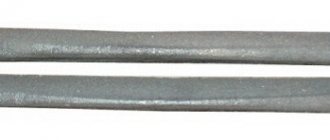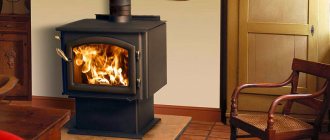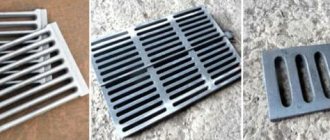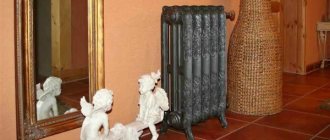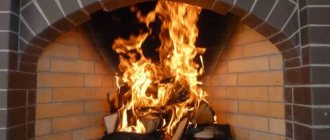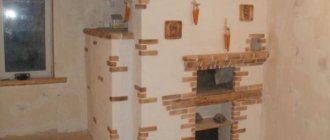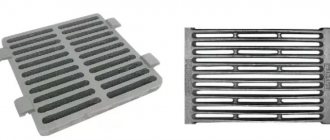The wood stove is one of those ancient inventions of mankind that is still widely used today. The design of these structures, of course, has changed and improved over time in order to increase operational efficiency and expand functionality. However, the presence of some departments and parts remained unchanged - this is the combustion chamber, the chimney pipe, the valves and, of course, the grate for the stove.
Grate for the furnace
The grate is essentially a separator between the combustion chamber and the ash pan. In addition, thanks to its lattice configuration, air supply is provided, without which no solid fuel combustion process is possible. It is clear that the grate constantly experiences extreme thermal loads, and therefore internal stresses, which imposes special requirements on its design and material of manufacture.
Therefore, most often, even in home-made stoves, they try to use factory-made grates - models that have been proven in operation, the durability of which you can rely on. The dimensions, configuration and cost of the grate depend on the design of the furnace, the parameters of the combustion chamber, as well as the type of solid fuel used.
Main functions of grates
The grate is a structural element of the furnace, most often made of high-quality cast iron that can withstand high temperatures without compromising its integrity. It is installed in the bottom of the combustion chamber and serves as the basis for laying solid fuel. In stoves with a classic layout, a flow of air enters the fuel charge from below through the grate to ensure combustion. The ash into which the fuel turns during the combustion process is poured through the gaps of the grate into the ash pan, freeing the combustion chamber for new loading of firewood or coal. As the ash pan is filled, it is cleared.
The principle of air circulation through the ash pit and combustion chamber
In many ways, the operating efficiency of a heating device or structure depends on the design of the grate. Its slots or holes (depending on the features of the model) must freely allow air flows, regulated by a blower valve (door). Sometimes the special structure of the grille itself becomes a “regulator” of air flow.
An important point is the correct installation of the grate in its seat, which is arranged for this purpose in the lower part of the combustion chamber.
Grate bars are made not only of cast iron, but also of steel. But in household heating structures or appliances, owners almost always give preference to cast iron.
A little history
Previously, firewood was burned on a blind hearth - combustion air was supplied through a slightly open fire door.
This method has a fire hazard - coals may fall out of the firebox. It is also difficult to accurately select the optimal combustion mode - the regulator is very rough. The ash that covered the coals over time also did not contribute to the normal combustion of fuel - it is an excellent heat insulator (in the combustion chamber of a Russian stove, this is exactly how coals were stored in the ash for the next kindling). Therefore, they began to install a grate - a grate on the hearth through which oxygen enters the combustion zone. The ash is also removed through the grate - nothing interferes with the combustion processes. The absence of a grate or its damage is not critical - the stove operates without it. True, the efficiency is somewhat lower. And the zone of intense heating of the masonry moves below the hearth - now the base of the ash chamber is also heated. And here you need to be careful if the stove is installed on a wooden base.
Types of grates
Grate grates are divided into several varieties according to different criteria.
- So, they can be divided into monolithic and typesetting.
— Monolithic models of gratings are more common, they are much easier to install - they immediately fit into a nest prepared for them of the required dimensions. The wide range of shapes and sizes of gratings on sale most often allows you to get by with just this option.
Options for monolithic and prefabricated grate
— Prefabricated grate bars are assembled into a single structure directly at the seat. These can be modules with two or three jumpers.
A prefabricated grate is convenient in cases where the bottom of the combustion chamber has a complex geometric shape, that is, it should be narrower in one place and wider in another.
This also includes the so-called beam grate - this is also a stacked version, consisting of individual crossbeams. The elements of the beam grille must pass freely and be removed from the combustion chamber through the open door. Actually, if you look at it, it is precisely such a separate beam that is called a grate.
Prices for grates for ovens
grates for furnace
It is from these individual parts (grid bars) that a prefabricated beam grate is formed
In practice, monolithic grates, if necessary, can be combined with stacked elements, in the case of the same non-standard shape of the combustion chamber.
- The slab grate has a flat shape (usually rectangular, although there are also round grates). This product option is suitable for most solid fuel heating appliances - stoves, boilers, fireplaces. The slab grate is selected in accordance with the furnace design, which specifies the parameters of the seat.
Basket grate “Riva Grate”
- Basket type grate . This type of grate was previously widely used in fireplaces with open hearths. It is convenient because the firewood being laid is not on the surface of the grate, but as if inside it, without the risk of falling out through the open hearth. But at the same time, air access to the fuel is completely preserved.
Nowadays, basket grates are no longer used in fireplaces so often, since many home owners prefer mainly closed combustion chambers with panoramic glass doors. However, such grates are also available for sale. In addition, master blacksmiths willingly accept orders for their production according to individual projects. And then the basket grate also becomes a decorative part of the fireplace.
Basket grate for the fireplace, made to order by a craftsman
- A movable grate is usually intended for long-burning furnaces. The structure may consist of a frame and a grille installed in it on the axis. Another option is gratings with horizontal movement. Changing the position of the grate helps its self-cleaning - it helps to loosen slag or ash deposits and remove them into the ash pan chamber. In some cases, movable grates also change the geometry of the channels for incoming air, which is used to control the operating modes of the furnace.
One of the design options for a movable grate
There are models with sections rotating 180 degrees. However, this design must be included in the furnace design, since such movement of the grate requires special recesses in the brick wall. Therefore, these models have limitations in application and are quite expensive.
- Separately, it is worth highlighting the cooled type of grate , which is usually installed in hot water boilers or furnaces with a water heating circuit. In another way they are called “KROK” - “cooled grate”. This version of the product is made from monolithic heat-resistant pipes in which the coolant circulates, cooling their surfaces. Thus, the firebox maintains a temperature that ensures safe operation of the unit, and the heating system receives additional thermal potential.
Diagram of a KROK-type grate
Most often, the production of such grate structures uses rectangular or square pipes in cross-section, arranged in parallel, with a pitch of 15÷20 mm. In the interpipe space, at a distance of 20–30 mm relative to each other, sections of steel rods are welded, which are compensators for the rigidity of the grid. On one side, the grid pipes are connected to a collector that supplies cooled coolant from the “return” pipe of the heating circuit, and on the other to the outlet pipe, through which water then flows into the main heat exchanger of the boiler.
Specifications
There are many types of stoves, varying in size, type of fuel used, and other characteristics. Therefore, the grate for them will also be different. As for the material of the stove itself, it does not directly affect the choice. Grates are installed in brick, steel, and cast iron devices.
Type of design
There are gratings:
- monolithic;
- typesetting;
- refrigerated.
Monolithic are solid structures. Dimensions are selected depending on the depth and width of the combustion chamber.
Available to fit all standard firebox sizes. This option is the easiest to install.
The typesetting version is made up of individual rod elements. It is used if a standard one cannot be selected, for example, in non-factory-made ovens.
Important! Often the rods are wedge-shaped. When installing, they are positioned with the narrower part down. This increases service life
This increases service life.
Cooled ones are used in systems with heat exchangers. They are made of tubes through which coolant passes. Thus, the grate itself is cooled, and the overall efficiency increases. This option is more often used in solid fuel boilers. The temperature inside the chamber reaches 1000°C. Thanks to cooling, the material can withstand a similar thermal load.
Form
The grate bars differ in the shape of the canvas. Different types are used in different designs. The following types of gratings are available:
- flat;
- basket;
- movable;
- beam
Photo 1. Basket grate made of cast iron. This type of device is usually installed in fireplaces.
Flat (or tiled) - the most common type. They are installed not only in stoves, but also in boilers that burn solid fuel, as well as in fireplaces. They have a rectangular shape. The dimensions are standard, selected depending on the dimensions of the fuel chamber.
Baskets have curved edges, which is why the whole structure resembles a basket. Such structures are placed in open-type ovens intended for cooking. Since such stoves are rare nowadays, and the parts for them are also not very common.
Movable grates are installed in long-burning furnaces, where it is necessary to regulate the air flow. The design allows for the possibility of changing the width of the gaps. They have several sections and a shaft, thanks to which movement occurs. Rotation axes can be horizontal or vertical. An additional advantage is greater ease of cleaning.
Beams consist of individual crossbars (beams), which can be single or double. They are typically used in non-standard sized ovens.
Material
The temperature in the furnace is quite high, which forces craftsmen to make grates from special metals:
- The most durable is a cast iron oven grate.
- There are also steel parts, the most popular of which is antipyretic steel. Such grates are not susceptible to oxidation and corrosion when the flame burns, and also do not deform. These devices can have different sizes and shapes, the abundance of which makes it possible to choose a grate even for a non-standard stove model.
Size
The dimensions of the product depend on two parameters:
- dimensions of the furnace combustion chamber;
- type of fuel used.
In equipment operating on wood, peat and fuel briquettes, a width of 150-350 mm (in increments of 50 mm) is most often used.
The depth is usually 180 or 250 mm. The largest possible dimensions of standard models are 900x800 mm.
When coal burns, more harmful substances are formed. Therefore, the dimensions of the grille should be larger, from 300-350 mm on both sides.
In any case, gaps of at least 5 mm are left at the edges. They serve to compensate for expansion when heated.
Attention! When choosing a size, the weight of one load of fuel is also taken into account. Dimensions, especially thickness, are selected in such a way as to withstand this load
Solid and stacked
For convenient use, you can choose different grate designs:
- Solid. They look like monolithic gratings; they cannot be broken down into smaller components. Most manufacturers have standard oven grate sizes, focused on the most popular oven models. The choice of sizes of solid parts is quite large. Preference should be given to a certain product taking into account the fuel surface area.
- Stacked grates. They have a collapsible shape and can be assembled independently. The number of their components depends on the required area of the device. This guarantees their versatility, because the oven grate can be made in any size and is suitable for non-standard ovens.
Criteria for selecting grates for a furnace
The choice of grate is determined by several factors, which include the following:
- Type of heating device (structure).
- The type of fuel used - the grate model will depend on this point. If you plan to heat the stove with coal, then you should purchase more massive grates that can withstand considerable mechanical load and extremely high temperatures. Lighter weight products are suitable for wood fireplaces and stoves.
- The grate must correspond in size to the seat in the combustion chamber. More precisely, the dimensions of the grate are usually immediately included in the design of the furnace, based on the sizes of these products offered for sale.
- The distances between parallel grate bars for wood-burning stoves must total at least 40% of the grate area. This factor will help to avoid difficulties when cleaning the product from ash. In addition, gaps less than recommended will create obstacles to the free circulation of air flow. And this, in turn, will lead to a decrease in the productivity of the heating device, as well as to a decrease in the level of safety of its operation. Insufficient air exchange creates difficulties both for complete combustion of fuel and for normal traction. And the delay of combustion products is unacceptable, as this is fraught with very serious consequences.
If the gaps of the grate are larger than necessary, then not only ash, but also unburned fuel particles will fall into the ash pan. The consequence is a completely unnecessary waste of fuel, since unburned particles of firewood or coal that have fallen into the ash pan will no longer produce the expected heat transfer. And in this case, everything is not very good with security.
Options for grates and their cost
There are various options for grates on sale for installation in stoves, fireplaces and boilers. As mentioned above, these products are made of cast iron or steel.
Cast iron should always be considered the optimal material. And the best grade of cast iron for the manufacture of heat-resistant fittings is SCh-15 (20). This marking is often placed directly on the product.
Grate grates made of steel are cheaper and weigh significantly less than their cast iron counterparts. However, their service life is much shorter, since they begin to deform under the influence of high temperatures, becoming unusable. And if the purchase is planned with the expectation of many years of daily use of the stove, then it is better not to take steel grates into account at all. They are suitable for a decorative fireplace that is lit occasionally, or for a stove that is not used often. For example, it could be an outdoor barbecue complex - you can save on the cost of the product, and for periods of long downtime, the grate can be easily removed and stored in a utility room.
Many foundries are engaged in the production of grates. But you shouldn't think. That the shapes and sizes of products, as they say, “are taken from the ceiling.” This area also has its own standardization.
For example, the products of Litcom CJSC - Rubtsovsky Foundry Complex LDV - are in wide demand. All gratings are manufactured in accordance with the STO 3-2011 standard and developed strict technical conditions. The table below shows grates of different shapes and linear parameters, as well as their cost for 2018.
The symbols are quite clear.
“RU” – grate for coal,
"RD" - grate for firewood.
Products with such indices are intended for stoves, boilers and fireplaces for domestic use with a maximum thermal power of up to 8 kW.
If a grate is required for a more powerful furnace or boiler, then a model with the added letter index “P” - it indicates the purpose of the product for industrial furnaces or boilers, with a thermal power of 8 to 100 kW.
| Illustration | product name | Linear dimensions, mm | Weight, kg | Approximate cost, rub. (2018) |
| Industrial grate RU-P-10 | 350×100 | 4.5 | 520 | |
| Cast iron household grate RU-1. | 250×250×20 | 4.05 | 520 | |
| Household grate RU-2. | 300×200 | 4.6 | 500 | |
| Household grate RD-8. | 245×220 | 4.1 | 450 | |
| Household grate RD-4. | 250×250×25 | 4.9 | 565 | |
| Fireplace grate RD-7. | 290×135 | 1.66 | 290 | |
| Household grate RU-5. | 300×250 | 3.6 | 430 | |
| Grate catalyst RD-9. | 300×200 | 4.2 | 555 | |
| Household grate RD-6. | 380×250 | 6.4 | 695 | |
| Household grate RD-5. | 300×250 | 5.65 | 695 | |
| Industrial grate RU-P-2. | 520×200 | 14.1 | 1925 | |
| Industrial grate RU-P-1. | 410×200 | 9.96 | 1430 | |
| Industrial grate RU-P-5. | 910×250 | 33.3 | 3990 | |
| Industrial grate RU-P-11.1 | 550×230 | 20.82 | 2395 | |
| Industrial grate RU-P-11.3 | 800×230 | 30.55 | 3490 | |
| Industrial grate RU-P-11 | 618×230 | 23.4 | 2685 |
Of course, the assortment of one manufacturer shown in the table does not at all limit the offer of specialized stores. To decide on the choice of this element of baked fittings, if the meaning of the abbreviation in the model name is not clear, you can consult with the seller or a specialist in this field. But it’s not worth purchasing a grate of unknown origin, as it can fail at the most unnecessary moment. And there are fakes, even those made from some alloys of unclear composition, but passed off as high-quality gray cast iron.
It is important to remember that if the stated material for the grate is cast iron, then by default it cannot be too light and attractively cheap.
Prices for cast iron grates for stoves
cast iron grate for furnace
Installation of grate
The grate is usually installed during the construction of the furnace. However, sometimes it is necessary to replace it in an already operating heating device or structure. In this case, it is necessary to understand for what reasons this unit was damaged or fell out of its seat.
An example of installing a grate in the combustion chamber of a brick kiln being built
When building a brick oven, the seat must exceed the dimensions of the grate by 5 mm on each side of its perimeter - this thermal gap will be an excellent protection against damage to the masonry and from deformation of the metal part itself when heated to high temperatures. As you know, all materials expand when heated, but the linear expansion coefficients of brick and metal differ quite significantly, and this requires a mandatory compensation gap.
As a rule, the bricks framing the nest for the grate are cut slightly at an angle, approximately as shown in the illustration above. This makes it easier to install and, if necessary, dismantle and replace the grille, and simplifies the process of cleaning it.
These gaps between the brick and the lattice are filled with dry sand or a mixture of sand and clay. But under no circumstances should cement-containing mortar be used. Sometimes an asbestos cord is laid along these cracks.
As a rule, the plane of the grate should be one row of masonry below the fire door - this prevents burning coals from falling out when the stove is opened. Naturally, this rule must also be observed in fireplaces with an open firebox - the lower edge of the hearth should be higher than the grate.
The grate also needs to be correctly placed in place, without mixing up the sides. Very often, the grate lintels have a triangular (trapezoidal) shape in cross-section. In this case, the pointed side should face towards the ash pan.
In conclusion, it is necessary to briefly summarize the information presented above:
- The dimensions of the grates are most often subject to standards. When drawing up furnace designs, they usually start from these established dimensions. But if necessary, you can assemble a grate of a more complex or non-standard configuration using separate beam grates or small modules.
- The manufacturing material is selected depending on the selected fuel. But by far the best material for metal stove fittings, proven over many years of use, is cast iron. But even among cast iron grates there are divisions into wood-burning or coal stoves.
- When installing the grate, it is important to properly prepare the seat in advance.
- It is easiest to install monolithic grate bars. But the stacked and beam options expand the possibilities, usually last longer, and their maintainability is much better. It is easier to replace one, for example, cracked grate, than the entire grate.
However, some stove owners try to make grates for their appliances themselves. This is often motivated by the fact that really high-quality cast iron is too expensive. And what is now on sale, in their opinion, often does not stand up to criticism.
Yes, a steel grate will not last very long. But for a craftsman it is easier and cheaper to make a new one than to purchase a ready-made model.
Well, this point of view has its right to exist. For example, here is a video on this topic:
Ways to solve the problem
If the grate is damaged, there are two options: fill the ash chamber with a brick or install a new grate.
The option of filling is acceptable only if the integrity is damaged or there are cracks and it is impossible to eliminate them at the base of the ash pit. At the same time, it would be good to replace the firebox door from a blank door to a door with a grille to regulate the flow of secondary air. But this option will definitely create a lot of unnecessary trouble and reduce the efficiency of the furnace. Therefore, we change the grate.
The grate is usually made of cast iron. Cast iron is very different from brick in terms of CTE - coefficient of thermal expansion. This indicator for iron is much higher than for ceramics. Therefore, the grate is always placed freely with a gap of 5-10 mm around the entire perimeter. Some manuals recommend filling the gaps between the masonry and the grate with sand. But this is very stupid advice. Unnecessary and even harmful. Firstly, the sand from the heat of the coals (and it can reach 1100 degrees Celsius) simply sinteres - vitrifies, tightly welding the grate to the masonry and depriving it of the necessary freedom. Secondly, after the first fire, this gap is filled with ash - a non-flammable and non-caking material. So why make unnecessary movements?
The figure shows the correct (bottom) and incorrect (top) position of the grate
Usually the grate is placed in a brick trough or in grooves selected in the brick. If the integrity of these grooves is damaged and it is impossible to restore them, you will have to come up with some kind of supports. Sometimes they try to get out of the situation by driving nails, metal plates, etc. into the seams of the masonry. All this is in vain - the metal is quickly tempered and ceases to hold the grate, and more massive pieces of iron are unacceptable - they will tear the masonry.
